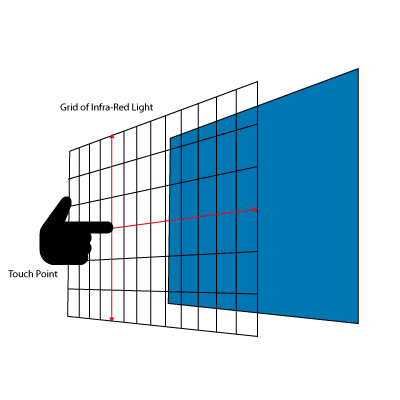Touch is the first sense we develop as human beings, even before we are born. It is a fundamental part of our everyday lives, providing us with a connection to the world and those around us. From the gentle strokes of a loved one’s hand to the firm grip of a handshake, touch plays a crucial role in our physical, social, and emotional well-being.
But what exactly is touch? How does it work? And what impact does it have on our daily lives? In this article, we will explore the fascinating world of touch – from its definition and importance to its different types and benefits. So, let’s dive in and discover the power of our most vital sense.
Outline:

- Defining Touch: The Basics
- The Senses of Touch: How We Feel
- The Benefits of Touch: Physical, Social, and Emotional
- Types of Touch: From Gentle Caresses to Firm Grasps
- The Role of Touch in Our Lives: From Infancy to Adulthood
- Enhancing Touch: Tips for Making Meaningful Connections
1. Defining Touch: The Basics

What is Touch?
Touch can be defined as the act of making physical contact with something or someone. It is a complex sense that involves the stimulation of nerve endings in our skin which sends signals to our brain, allowing us to feel sensations such as pressure, temperature, texture, and pain. Simply put, touch is the ability to perceive and respond to physical contact with the outside world.
Apart from being one of our five senses, touch is also considered a primary sense as it is present in all living beings. It is an essential aspect of our survival, enabling us to interact with the environment and others. Without touch, we would not be able to navigate the world around us, communicate effectively, or form meaningful connections with others.
The Science of Touch
The sense of touch is made possible by specialized nerve endings, known as tactile receptors, which are located in the skin and connect to our central nervous system. These receptors are responsible for detecting different types of stimuli, such as pressure, temperature, and pain. They then send these signals to our brain, where they are processed and interpreted, allowing us to make sense of our surroundings.
There are four main types of tactile receptors:
- Mechanoreceptors: These receptors respond to mechanical stimuli, such as pressure, vibration, and stretching.
- Thermoreceptors: These receptors respond to changes in temperature.
- Nociceptors: These receptors respond to painful stimuli.
- Proprioceptors: These receptors are found in our muscles, joints, and tendons, and they provide information about the position and movement of our body.
Together, these receptors work in harmony to give us a complete picture of the world through touch. For instance, when you hold an object, your mechanoreceptors will detect the pressure and texture of the object, while your thermoreceptors will inform you if it is hot or cold, and your proprioceptors will let you know how to hold it securely without dropping it.
The Importance of Touch
Touch plays a vital role in our survival, development, and well-being. As human beings, we have an innate need for physical contact, and touch is the primary way we fulfill this need. In fact, studies have shown that lack of physical contact can have detrimental effects on our health and social functioning.
Infants, for example, require touch for their physical, emotional, and cognitive development. According to research, premature babies who receive daily massages have been shown to gain weight faster, be more alert, and have better sleep patterns compared to those who do not receive touch therapy. Touch is also essential for the bonding process between parents and their newborns, creating a sense of security and trust.
Touch is not only vital in infancy, but it continues to play a crucial role throughout our lives. From childhood to adulthood, touch helps us communicate, form relationships, and express emotions. It can also have positive effects on our overall well-being, as we will explore further in the following sections.
2. The Senses of Touch: How We Feel

As previously mentioned, touch allows us to experience a wide range of sensations, from gentle caresses to painful jabs. To better understand how touch works and why it is so important, let’s take a closer look at the different types of sensations that we feel through touch.
Pressure
Pressure is one of the most common sensations we experience through touch. It is the result of physical contact with an object or person, and it can vary in intensity and duration. For instance, a firm handshake will exert more pressure than a light tap on the shoulder, while a hug will provide continuous pressure over a longer period.
The perception of pressure is influenced by various factors, such as the type of touch, the location of the stimulus, and the emotional state of the individual. For example, a light touch may feel pleasant on the arm, but uncomfortable on the face.
Temperature
Our skin is equipped with thermoreceptors that are responsible for detecting changes in temperature. This allows us to feel whether something is hot or cold, and respond accordingly. Our perception of temperature can vary depending on the part of the body being touched. For instance, our hands are more sensitive to cold temperatures, while our back is more sensitive to heat.
Temperature also plays a significant role in our social interactions. Warmth and affection are often associated with positive emotions, while coldness can be perceived as negative or distant. This is why a warm embrace from a loved one can be so comforting, while a cold handshake from a stranger can feel unpleasant.
Texture
Texture is the surface quality of an object or material, and it can be perceived through touch. Our skin is equipped with different types of mechanoreceptors that respond to various textures – from rough and smooth to hard and soft. This allows us to differentiate between materials and objects, and form associations based on our previous experiences.
For instance, we may associate rough textures with discomfort or danger, while smooth textures may evoke feelings of comfort and safety. Our perception of texture can also be influenced by cultural and personal preferences. For example, a person may enjoy the feeling of a soft blanket against their skin, while another may find it irritating.
Pain
Pain is an essential part of touch, as it serves as a warning sign for potential harm or injury. Our nociceptors are responsible for detecting pain, and they can be triggered by a wide range of stimuli, such as heat, pressure, or chemicals. When activated, these receptors send signals to our brain, which then interprets them as pain.
The perception of pain can vary greatly from person to person. Some individuals may have a higher pain threshold, while others may be more sensitive to certain types of pain. Pain can also be influenced by psychological factors, such as stress, anxiety, and past experiences.
3. The Benefits of Touch: Physical, Social, and Emotional

Apart from the sensory experience, touch has numerous benefits for our physical, social, and emotional well-being. From boosting our immune system to improving our relationships, let’s explore the different ways in which touch can positively impact our lives.
Physical Benefits
The physical benefits of touch are well-documented and supported by science. One of the most evident effects of touch is its ability to soothe and relax our body. When we are touched, our bodies release oxytocin, a hormone known as the “love hormone” due to its role in promoting feelings of love and bonding. Oxytocin also helps to reduce stress hormones, such as cortisol, which can have damaging effects on our health if left unchecked.
Additionally, touch has been found to have pain-reducing effects, thanks to the release of endorphins in our body. Endorphins are natural painkillers that are produced in response to physical contact, resulting in a decrease in pain perception and an increase in feelings of well-being.
Social Benefits
Human beings are social creatures, and touch is essential for building and maintaining relationships. In fact, studies have shown that people who regularly engage in appropriate physical contact with others tend to be happier, more empathetic, and better at communicating their emotions.
Touch is also instrumental in creating and strengthening bonds between individuals. From romantic partners to family members and friends, touch plays a crucial role in promoting feelings of closeness, trust, and security. It is no wonder that we often turn to a hug or a hand on the shoulder to express our love, comfort, and support for those closest to us.
Emotional Benefits
The emotional benefits of touch go beyond just making us feel good. Touch has been found to have healing effects on our mind and soul, helping us cope with stress, anxiety, and other mental health issues. For instance, massage therapy has been shown to reduce symptoms of depression, while cuddling and hugging can help to alleviate feelings of loneliness and isolation.
Moreover, touch can also improve our mood and increase feelings of positivity. This is because the act of touching stimulates the production of dopamine and serotonin – neurotransmitters that are responsible for regulating our mood, sleep, and pleasure. By increasing these “feel-good” chemicals, touch can help us experience greater happiness and satisfaction in life.
4. Types of Touch: From Gentle Caresses to Firm Grasps

As we have seen so far, touch plays a significant role in our daily lives, and it comes in many forms. From the gentle caresses of a loved one to the firm grasps of a handshake, each type of touch carries its own meaning and serves a different purpose. Let’s explore some of the most common types of touch and their significance.
Gentle Touch
Gentle touch is characterized by light pressure and delicate movements on the skin. It can take the form of a soft stroke, a light tap, or a gentle rub. In most cases, gentle touch is associated with positive emotions, such as love, affection, and comfort. This type of touch is often used in social interactions, such as greetings, expressions of gratitude, and comforting gestures.
Firm Touch
Firm touch involves applying pressure with more force than gentle touch, while still maintaining control and intention. It can be perceived as a strong grip, a pat on the back, or a tight hug. Unlike gentle touch, firm touch is often associated with power, assertiveness, and authority. As such, it is commonly used in professional settings, such as a handshake in a job interview or a high-five after a team’s success.
Affectionate Touch
Affectionate touch is any type of touch that conveys love, warmth, and tenderness. It includes gentle and firm touches, as well as other non-verbal expressions of love, such as cuddling, kissing, and holding hands. Affectionate touch plays a crucial role in building and maintaining intimate relationships, strengthening bonds between partners, and promoting feelings of trust and security.
Sexual Touch
Sexual touch refers to any type of touch that is intended for sexual pleasure and arousal. It can vary from light and gentle touches to more intense and stimulating movements. Sexual touch is often part of consensual sexual activities between romantic partners and can involve the whole body, not just the genitals. It is an essential aspect of human sexuality and can have positive effects on our physical, emotional, and relational well-being.
Therapeutic Touch
Therapeutic touch involves the use of touch as a means of promoting healing and relaxation. It is commonly used in massage therapy, energy healing, and other forms of bodywork. With therapeutic touch, the focus is not on the type of touch itself but on its intention and purpose. It aims to improve physical and emotional well-being by relieving tension, reducing pain, and providing a sense of comfort and connection.
5. The Role of Touch in Our Lives: From Infancy to Adulthood
From the moment we are born, touch becomes an integral part of our lives and continues to play a crucial role throughout our development. Let’s take a closer look at how touch impacts us from infancy to adulthood.
Infancy
Infants rely heavily on touch for their survival and development. In fact, touch is so essential that skin-to-skin contact between a newborn and their parent has been shown to have numerous benefits, such as stabilizing the baby’s heart rate and temperature, increasing milk production in mothers, and promoting bonding between parent and child.
As babies grow, they continue to need touch for their physical, social, and emotional development. Studies have shown that infants who receive regular massages have better sleep patterns, weight gain, and cognitive development than those who do not receive touch therapy. Touch also plays a crucial role in the attachment process between parent and child, creating a sense of security and trust.
Childhood
Children continue to rely on touch for their development as they grow. As they become more mobile and independent, touch can help children feel safe and secure while exploring the world around them. It can also aid in regulating emotions, reducing stress and anxiety, and improving cognitive and social skills.
During childhood, children also start to learn about the different types of touch and how to use them appropriately. They learn that gentle touches convey love and affection, while firm touches may be used for play or to express frustration. This understanding is essential in helping children form healthy relationships and communicate their needs effectively.
Adulthood
Touch remains an essential aspect of our lives well into adulthood. As we go through different stages and experiences, touch can help us cope with stress, improve our physical and emotional well-being, and strengthen our relationships. In intimate relationships, touch plays a crucial role in maintaining closeness and intimacy, strengthening bonds between partners, and promoting sexual satisfaction.
In day-to-day interactions, touch can also have a positive impact on our social lives. It can help us connect with others, build trust and rapport, and create a sense of belonging. Touch is often used as a means of showing support, appreciation, and empathy towards others, making it a powerful tool in communication and relationship-building.
6. Enhancing Touch: Tips for Making Meaningful Connections
Touch is an incredibly powerful sense, and it can bring numerous benefits to our lives. However, not all types of touch are created equal, and it is crucial to understand how to use it appropriately to make meaningful connections with others. Here are a few tips for enhancing touch in your daily life:
- Be mindful of consent: Always ask for permission before touching someone. Respect their boundaries and preferences.
- Pay attention to context: Different types of touch may be appropriate in different contexts. For instance, a hug may be acceptable with a close friend but not with a stranger.
- Use touch to express emotions: Touch can help you express yourself beyond words. Use it to show love, gratitude, or support towards others.
- Be aware of cultural differences: Touch can be perceived differently across cultures. Research the cultural norms of the people you interact with to avoid offending them.
- Practice good hygiene: Make sure your hands are clean and free from any offensive smells before touching someone. This shows respect for the other person’s boundaries and comfort.
- Be considerate of others’ feelings: Be mindful of how your touch is received by others. If someone seems uncomfortable, respect their feelings and give them space.
In conclusion, touch is a fundamental part of our lives that helps us connect, communicate, and thrive. It is a powerful sense that goes beyond just providing physical sensations, as it can also have significant impacts on our social, emotional, and relational well-being. By understanding the types of touch and using it appropriately, we can enhance our connections with others and improve our overall quality of life. So, go ahead and give someone a meaningful touch today!Touch is an essential aspect of human interaction and communication. From the moment we are born, touch plays a vital role in our development and continues to impact us throughout our lives. Understanding the different types of touch and learning how to use it appropriately can enhance our relationships, improve our well-being, and deepen our connections with others.
Importance of Mindful Touch
Mindful touch refers to being present and intentional with our physical interactions with others. It involves paying attention to the quality of touch, the emotions being conveyed, and the responses of the recipient. Practicing mindful touch can significantly enhance the effectiveness of our communication and the quality of our relationships.
Benefits of Mindful Touch
One of the primary benefits of practicing mindful touch is the ability to convey empathy and understanding effectively. When we are fully present and attentive during a physical interaction, we can better sense the emotions and needs of the other person. This helps in building trust, fostering deeper connections, and resolving conflicts more easily.
Additionally, practicing mindful touch can enhance the overall quality of our relationships. By being aware of the impact of our touch on others, we can avoid misunderstandings, respect boundaries, and create a more harmonious and respectful environment. This leads to greater satisfaction in our interactions and a stronger sense of connection with those around us.
Tips for Practicing Mindful Touch
- Stay Present: Focus on the present moment and be fully engaged in the interaction.
- Be Attentive: Pay attention to the other person’s verbal and non-verbal cues to understand their feelings and needs.
- Respect Boundaries: Honor the other person’s limits and preferences regarding touch.
- Express Care: Use touch to show care, support, and affection towards others.
- Reflect on Impact: Reflect on how your touch is received and adjust accordingly to ensure positive interactions.
By incorporating mindful touch into our daily interactions, we can foster healthier relationships, improve communication, and create a more compassionate and empathetic environment for ourselves and those around us.
Types of Mindful Touch
Mindful touch encompasses various types of physical interactions that can convey different emotions, intentions, and messages. Understanding these types of touch can help us use them effectively to enhance our connections with others.
Gentle Touch
Gentle touch involves using light pressure and soft movements to convey care, comfort, and tenderness. It is often associated with feelings of warmth, compassion, and love. Gentle touch can be soothing and calming, making it ideal for showing support, empathy, or affection towards others.
- Examples of Gentle Touch:
- Holding hands
- Lightly stroking someone’s arm
- Gently patting someone’s back
Firm Touch
Firm touch is characterized by using moderate to strong pressure during physical interactions. It can signify confidence, assertiveness, and strength. Firm touch is commonly used to express enthusiasm, excitement, or authority in social interactions.
- Examples of Firm Touch:
- Giving a firm handshake
- Applying pressure during a massage
- Playfully tapping someone’s shoulder
Expressive Touch
Expressive touch involves using gestures and movements to convey emotions, thoughts, and intentions non-verbally. It can include a wide range of actions, such as hugs, kisses, and hand-holding. Expressive touch plays a crucial role in expressing feelings of love, friendship, and support in interpersonal relationships.
- Examples of Expressive Touch:
- Embracing someone in a hug
- Kissing a loved one on the cheek
- Holding hands with a partner
By recognizing the different types of mindful touch and their meanings, we can effectively use them to strengthen our connections, communicate our emotions, and build more meaningful relationships with others.
Incorporating Mindful Touch into Daily Life
Practicing mindful touch is not limited to special occasions or specific relationships; it can be integrated into our daily interactions with friends, family, colleagues, and even strangers. By being conscious of our physical connections with others and approaching them with intention and empathy, we can create more positive and enriching experiences in our everyday lives.
Everyday Gestures of Mindful Touch
- Greetings: Offer a warm handshake, a friendly hug, or a gentle pat on the back when greeting someone.
- Listening: Place a comforting hand on the arm or shoulder of a friend or loved one while they are sharing their thoughts and feelings.
- Support: Hold hands with a partner or friend to provide reassurance, comfort, or encouragement during challenging times.
- Appreciation: Express gratitude and appreciation through touch by giving a high-five, a thumbs-up, or a supportive squeeze on the arm.
- Connection: Foster a sense of connection and unity by engaging in physical activities together, such as dancing, walking arm in arm, or participating in group exercises.
Incorporating these everyday gestures of mindful touch can help us cultivate closer relationships, improve our communication, and create a more compassionate and empathetic community around us. By being intentional with our physical interactions and approaching them with mindfulness and care, we can enhance the quality of our connections and bring more joy and fulfillment into our lives.
Conclusion
Touch is a powerful sense that influences every aspect of our lives, from infancy to adulthood. It serves as a fundamental means of communication, connection, and expression of emotions. By understanding the different types of touch and learning how to use touch mindfully, we can enhance our relationships, improve our well-being, and create more meaningful connections with others.
From therapeutic touch that promotes healing and relaxation to sexual touch that enhances intimacy and pleasure, touch plays a diverse and essential role in our lives. By practicing mindful touch, respecting boundaries, and being attentive to the needs and feelings of others, we can maximize the positive impact of touch on our physical, emotional, and relational well-being.
So, the next time you reach out to someone with a hug, a handshake, or a pat on the back, remember the power of touch to convey care, support, and understanding. Embrace the art of mindful touch in your daily interactions, and watch as your relationships flourish, your connections grow deeper, and your life becomes more enriched with the beauty of human connection through touch.


